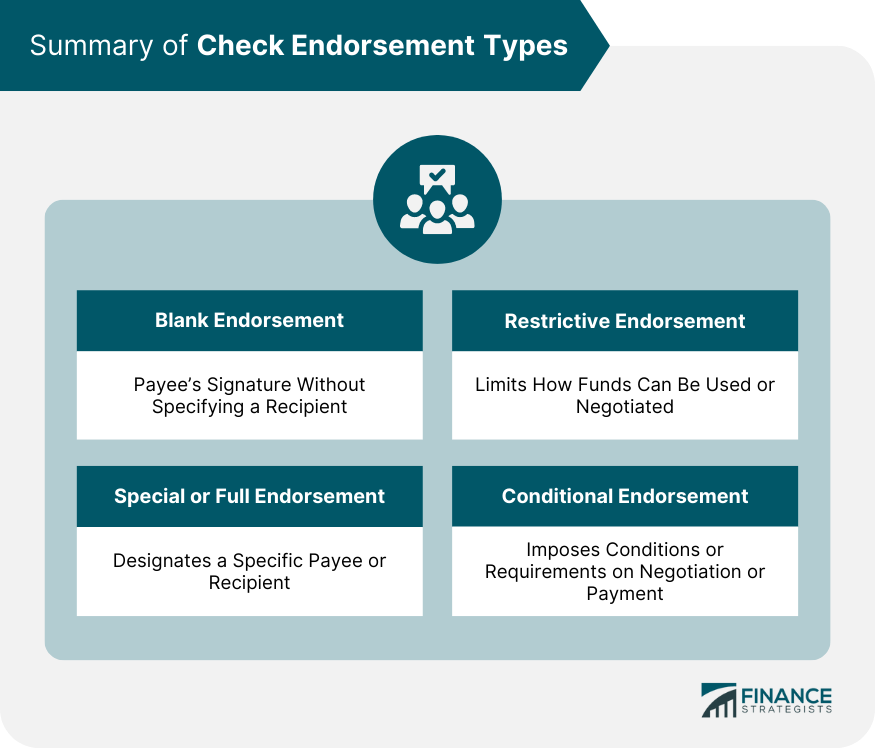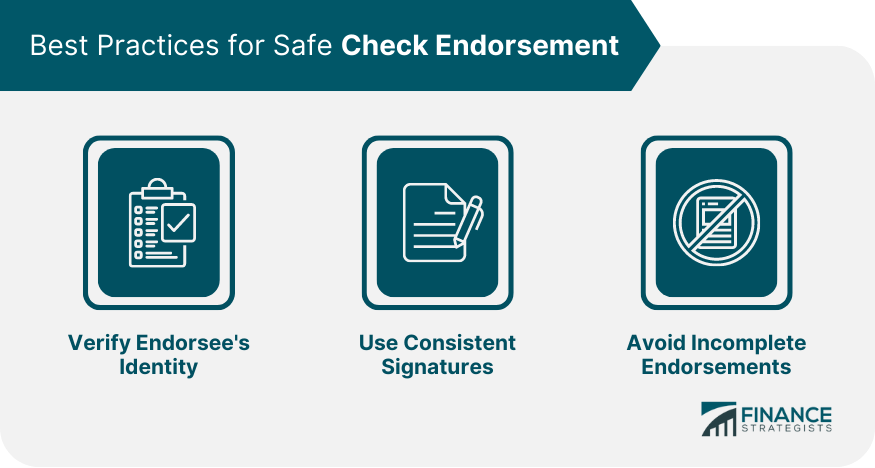A check endorsement is the act of signing the back of a check, signaling permission for the check to be processed or cashed. The endorsement authenticates the check, indicating that the payee (the person or entity the check is written out to) acknowledges receipt and approves the transfer of funds. There are various types of endorsements, each serving a different purpose and offering varying levels of security and flexibility. These can range from a simple signature (blank endorsement) to more specific endorsements like restrictive (limits the check's use) and special or full (designates another recipient). Conditional endorsements add terms that must be met before cashing or depositing. Understanding the type and purpose of check endorsements is essential for both personal and business financial transactions to ensure smooth and secure processing, guarding against potential pitfalls and promoting confidence in monetary exchanges. This refers to a type of endorsement on a check where the payee's signature appears on the back of the check without specifying a specific recipient. This endorsement essentially turns the check into a bearer instrument, meaning that anyone who possesses the endorsed check can cash or deposit it. When a check is endorsed with a blank endorsement, it becomes negotiable, and the person in possession of the check can present it to a bank or financial institution and receive the funds. This type of endorsement is typically used when the payee wants to transfer the check to someone else or when the payee wants to convert the check into cash. A blank endorsement's primary advantage is its simplicity, making transactions straightforward. On the other side, its openness means that if the check is misplaced, anyone who picks it up has the ability to cash or deposit it. This leaves room for potential fraud, especially if the check is of significant value. An endorsement on a check that designates a specific payee or recipient. Unlike a blank endorsement, where the payee's signature is the only requirement, a special endorsement includes additional information, such as the name of the person or entity to whom the check is being transferred. To make a special endorsement, the payee must sign the back of the check and then write a specific statement indicating the name of the person or organization to whom they are transferring the funds. This endorsement restricts the negotiation of the check to the named payee or the individual or entity they specify. A special or full check endorsement provides a greater level of security compared to a blank endorsement because it specifies the intended recipient of the funds. It helps ensure that only the designated person or entity can negotiate the check and reduces the risk of unauthorized individuals cashing or depositing the check. But with added security can come added complications. Errors in naming the new payee or mismatches in signatures can lead to transactional hiccups, sometimes necessitating reissuance or additional bank visits. A restrictive endorsement is a type of endorsement on a check that limits or restricts how the funds can be used or negotiated. It includes specific instructions or conditions for the deposit or negotiation of the check. When using a restrictive endorsement, the payee signs the back of the check and includes a statement that indicates the purpose or restriction of the funds. This statement can be as simple as writing "For deposit only" or "For [specific purpose]" above the signature. Restrictive endorsements provide an extra layer of protection against unauthorized use or mishandling of funds. They help ensure that the funds are used according to the payee's intentions and can assist in tracking the purpose or destination of the funds. However, this very attribute can also be its downside. Should the endorser change their mind or need to use the check differently, this endorsement type can prove restrictive and burdensome. A conditional endorsement is a type of endorsement on a check that imposes certain conditions or requirements on the negotiation or payment of the check. It allows the payee to specify additional terms or instructions related to the endorsement. For example, a payee might write "Payable to John Smith upon completion of repairs" or "Payable to Jane Doe after approval of contract." These statements indicate that the check can only be negotiated or paid once the specified conditions are satisfied. The specific conditions or requirements in a conditional endorsement can vary based on the payee's needs or intentions. However, it's important to note that the acceptance and enforceability of such endorsements may vary depending on the banking policies, legal requirements, and the willingness of the bank or the recipient to honor those conditions. To ensure clarity and legal validity, it is recommended to consult with a financial advisor, attorney, or banking professional for guidance on using conditional endorsements, as they can have implications on the negotiability and payment of the check. In this digital age, with increasing cases of identity theft and fraud, extra caution is a necessity. When transacting, especially with unfamiliar parties, it's vital to ensure the check is going to or coming from a genuine source. Verification can be achieved through identity checks, transaction confirmations, or even simple direct communication with the involved bank. It's advisable to verify the authenticity of the payee's identity by comparing identification documents or conducting online searches if necessary. Requesting transaction confirmations or contacting the bank directly can provide an additional layer of security and assurance. Institutions like banks maintain signature records for their customers. When a signature on a check doesn't match what's on file, it can raise red flags, causing delays or potential rejection. Maintaining a consistent signature across all financial dealings smoothens transactions and minimizes the risk of discrepancies. Individuals should strive to use the same signature consistently on all financial documents, including checks. If a signature has evolved or changed over time, notifying the bank and updating the signature on file can help prevent complications and ensure a seamless endorsement process. A clear and complete endorsement reduces the risk of disputes and misunderstandings. Especially when dealing with endorsements that involve conditions or specific instructions, clarity is important. Ambiguities or hastily written instructions can prove problematic, stalling transactions or leading to unintended outcomes. When providing endorsements, take the time to clearly express any conditions or instructions associated with the endorsement. Use legible handwriting and ensure that all necessary information is included, such as specific names, account numbers, or purposes. This helps avoid confusion and ensures that the check is processed accurately according to your intentions. Choosing the best endorsement for a check requires careful consideration of individual needs and circumstances. Blank endorsements offer convenience but lack security and control. Special endorsements provide security and designate specific recipients, but they can lead to complications if errors occur. Restrictive endorsements add protection and purpose, but they may prove restrictive if circumstances change. Conditional endorsements allow for specific conditions but depend on acceptance and enforceability. To ensure safe endorsements, verifying the endorsee's identity is crucial in a digital age plagued by fraud. Consistent signatures across financial dealings facilitate smoother transactions. Avoiding incomplete endorsements reduces disputes and confusion. By following best practices, individuals can enhance security and confidence in monetary exchanges. Seeking professional advice will help make an informed decision that aligns with one's goals and ensures smooth and secure check processing.What Is a Check Endorsement?
Types of Check Endorsement
Blank Endorsement
Special or Full Endorsement
Restrictive Endorsement
Conditional Endorsement

Best Practices for Safe Endorsement
Verify Endorsee’s Identity
Use Consistent Signatures
Avoid Incomplete Endorsements

Conclusion
Types of Check Endorsements FAQs
A blank endorsement is when the payee signs the back of a check without specifying a recipient, making it a bearer instrument that can be cashed or deposited by anyone in possession of the endorsed check.
A special endorsement is when the payee signs the back of a check and designates a specific person or entity as the recipient, limiting the negotiation of the check to that designated party.
A restrictive endorsement is when the payee signs the back of a check and includes specific instructions or conditions for the deposit or use of the funds, such as "For deposit only" or "For [specific purpose]."
A conditional endorsement is when the payee signs the back of a check and imposes certain terms or requirements on the negotiation or payment of the check, indicating that it can only be processed or cashed upon meeting those conditions.
To choose the best endorsement type, consider your priorities, assess the level of security and control you need, understand the risks and benefits of each type, and evaluate the specific requirements of the transaction. Seeking professional advice can also help in making an informed decision.
True Tamplin is a published author, public speaker, CEO of UpDigital, and founder of Finance Strategists.
True is a Certified Educator in Personal Finance (CEPF®), author of The Handy Financial Ratios Guide, a member of the Society for Advancing Business Editing and Writing, contributes to his financial education site, Finance Strategists, and has spoken to various financial communities such as the CFA Institute, as well as university students like his Alma mater, Biola University, where he received a bachelor of science in business and data analytics.
To learn more about True, visit his personal website or view his author profiles on Amazon, Nasdaq and Forbes.











